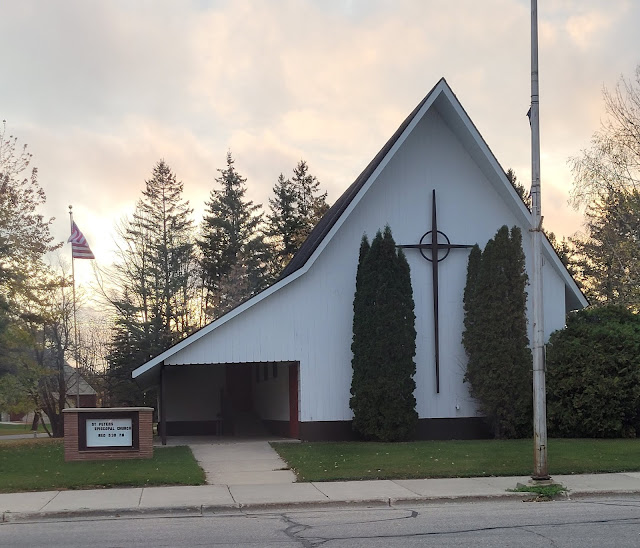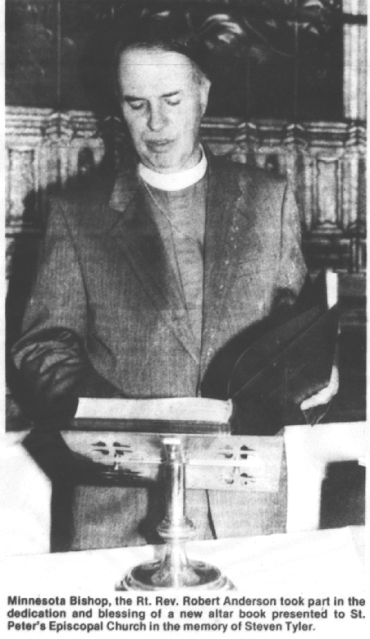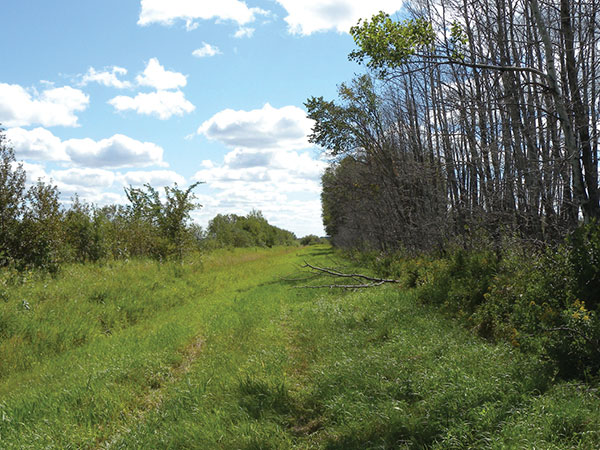Warroad Houses of Worship Part III — St. Peter's Episcopal
Many people have heard of the Episcopal domination of Christianity, but few outside of that denomination know what that means. The Episcopal Church is part of the broader Protestant denomination of Christianity. The church was originally organized after the American Revolution to separate the American churches from the Church of England, whose clergy were required to swear allegiance to the British monarchy. The church has grown to include a distinct mixture of Protestant and Catholic beliefs and traditions.
 |
| Young girl outside the old Baptist Church in Warroad.* |
In 1903, the first Episcopal service occurred in Warroad by Reverend Mitchell from Hallock. At the time, there was no church building available for the service, so it was held in the home of Charles A. Moody, known as the Father of Warroad. At that time in 1903, the women of the community who wished to formed a Ladies' Episcopal Guild, with Mrs. C. A. Moody serving as president of the organization.
By 1904, there was only one church building operable in Warroad: the Baptist church. Built in 1904, the Baptist church was the home of multiple church denominations in the early years of Warroad, and it also served as a schoolhouse prior to the building of one specifically for school use. Services for the Episcopal church were done by both Rev. Mitchell and Bishop J. D. Morrison of Duluth. It was Morrison who began pushing for the establishment of a permanent Episcopalian church in the area.
In 1905, Rev. Thomas R. Alleeson arrived from Duluth to take up services in Warroad, followed shortly afterwards by Rev. George Holloway. By mid-1906, it was determined that the congregation required a building of its own. The Baptist building was purchased by the Episcopalians at the end of 1906, with plans to remodel it after the holiday season and once the newly built school building could house those displaced in the Baptist church. The church was christened the All Saints Episcopal Parish on November 15, 1906.
The church remodeling was done through funds gained by the small congregation. By February 1907, the interior had been completely renovated with new pews, wainscoting, platforms, and alter steps. Future projects were listed for the construction of a new alter, prayer desk, and lectern. The projects were overseen primarily by the All Saints Guild, that same Ladies' Episcopal Guild that began this journey in 1903. In March 1907, the church was rechristened as St. Peter's Episcopal Church alongside Williams' Episcopal Church choosing the name St. James'.
In 1908, the ladies of St. Peter's produced a neat little cookbook called Wingi-Po-Gud, featuring only recipes with ingredients that could be locally sourced and only 75 cents for purchase (Current USD: $22). Later that year, the Episcopal Guild produced a Thanksgiving play, performed at the local opera house. The cast included Clara Aldrin, May Randall, Alma Aldrin, Belle Miller, Cora Moody, Amed Soderstrom, W. P. Smith, E. A. Linder, F. H. Brown, and George Sperling.
 |
| Second edition of the Episcopal cookbook in the museum archives. |
Rev. Alleeson departed from Warroad at the end of 1909 for Spokane, Washington. His duties were overtaken by the Bishop Morrison of Duluth every few weeks, along with a host of other itinerant pastors who passed through the area. In 1911, the church was moved from Lake Street to Roberts Street. A beautiful altar cloth was provided for the church by Irene (Parker) Horr. It was embroidered in the All Saints' Episcopal Convent in Bombay, India.
 |
| Rev. James D. Morrison, first Bishop of Duluth |
Over the next decade, very little changed within the Episcopal denomination of Warroad. A new rector, Rev. Elmer Johnson of International Falls, was added to the Episcopal Church in April 1931. He held services twice a month at St. Peter's. In August of that year, it was reported that members of the church were interested in building a new church for their congregation, a decision which received great enthusiasm from the Right Rev. Bishop Kemmerer and the rector Rev. Johnson (WP 08/20/1931).
 |
| Rev. Benjamin Tibbets Kemerer |
Throughout its early years, it seems St. Peter's operated every other week, with various pastors arriving from Duluth, International Falls, and Thief River Falls to perform services. In between these services, the Episcopal Guild continued holding meetings in each other's houses and hosted suppers for the local community.
In 1938, the church diocese in Duluth promoted fasting for all church members in sympathy for the sufferers of Japanese occupation in China. Japan invaded China in 1931 with the intent of overtaking the entire nation, cutting off Russia at the border, and moving on to take all of Southeast Asia. The brutality suffered by the Chinese during this time was unimaginable. A well-known Episcopal congregation resided in Shanghai, and it was said that one low-priced meal for an American could feed a Chinaman for up to one week. The fast also promoted an offering and donation program for China (WP 01/27/1938).
Later that year, Rev. Robert J. H. Rayner and his wife were welcomed by the Episcopal Guild as the new rector of the church. A luncheon was hosted at the Parish Hall in August 1938. Like previous years, church meetings were few and far between, based primarily on the ability of men and women of the congregation traveling in bad weather and the availability of Rayner or another pastor to perform the service.
Rev. Rayner and his wife left the diocese of Duluth for Mandan, ND in February 1943. Services for the next few years were periodically conducted by either Lay Reader A. M. Anderson (The name is sometimes written as A. M. Sanderson) and Rev. Charles Gaskill of International Falls. Gaskill was followed in 1948 by Rev. Frederick K. Smyithe of Hallock, followed by Dr. Clyde Benner of Redby, MN from 1952, and various reverends and vicars from other churches in the region. In 1954, Rev. Jack MacNaughton came to town. Rev. MacNaughton performed Episcopal services three times a moth: evening prayer services every second and fourth Sunday, and morning prayers every third Sunday. The first Sunday of each month was performed by the Archdeacon Dawson of Winnipeg (WP 07/14/1954).
MacNaughton was officially ordained in late February 1955 by the Right Reverend Stephen E. Keeler. The ceremony was said to constitute "the advancement of Mr. MacNaughton to full privileges as a priest and pastor in Episcopal orders," (WP 03/02/1955). News of the Episcopal Church dies down for a short time after MacNaughton was ordained. He saw to the dedication of two memorials for the late Dr. Laurence Parker of this place. These memorials included a lighted picture of the doctor and a projector used to show film strips of interest to the church congregation. By this time, the congregation consisted of approximately 40 local members.
 |
| Rev. John H. "Jack" MacNaughton |
In 1956, Rev. MacNaughton announced at a special meeting that the church would be considering hiring a fulltime minister to take over St. Peter's church. He was succeeded first by Rev. Conrad Norquist of St. Louis Park, MN that year. Rev. MacNaughton passed away in Texas on February 28, 2022. Rev. Norquist a recent graduate from seminary school who would be making St. Peter's his first parish. Norquist was officially ordained in December 1959. Then, in 1961, St. Peter's welcomed Rev. William Jarvi of Two Harbors, MN. Jarvi would oversee the remodeling of the church throughout the end of 1961. The remodel included a new basement just south of the church and a moving of the building just over top of it. The exterior of the building received new shingles, siding, windows, and an overhang on the north side to cover the entrance sidewalk (WP 10/26/1961).
In 1963, the St. Peter's Episcopal Guild hosted a public tea in observation of the church's 60th anniversary. The Ladies' Guild was the oldest society in Warroad, headed by Annie McCagherty, a member for 58 years at that point and guild secretary for 36. McCagherty was said to be proud of the organization "into which so much church and town history has gone and which has sturdily kept St. Peter's doors open through pioneer days, the depression and two world wars, often without pastors and while neighboring congregations failed," (WP 06/26/1963).
 | |
|
Rev. Jarvi left Warroad in June 1964 and the community welcomed Rev. Joe Campbell and his wife in Jul, Rev. and Mrs. John Lowe in November 1965, though he only stayed a few months before services were handled sparsely by Paul Urtel, the Lay Reader, Rev. Bachelor of International Falls, and a Rev. Dorian from the church diocese.
In 1972, Rev. Smyithe returned to Warroad and to St. Peter's. He came to Warroad from International Falls twice a month until his final sermon in 1976. Smyithe accepted a position to preach at St. Paul's Church in Brainerd and St. John's Church in Aitken, MN. Rev. Frederick Smyithe passed away at Bemidji in 2014 from Alzheimers Disease. In September 1977 Rev. K. Carl Triskle was tapped to fill the empty pastoral position. Triskle performed monthly services at St. Peter's while also leading the congregations of Rainy River and Emo (WP 09-17-1977).
Sometime between 1980–1982, Rev. Triskle left the parish and was replaced in late April 1982 by Rev. Bill Gambling. Under Gambling, the church celebrated its 80th anniversary in June 1983. The celebration included an opening convocation and confirmation ceremony (confirmed was Terri Fulmer, Randi Marvin, and David "Izzy" Marvin), public tea with a short program and an organized fishing trip for the men of the parish that included a shore lunch with visiting clergy and members of the congregation. The celebration ended with communion followed by a church brunch (WP 06/22/1983).
 |
| L-R: Rt. Rev. Robert Anderson, Frank Marvin, Rose Parker, and Rev. Kenneth Umbehocker, 1988. |
In 1988, St. Peter's celebrated it's 85th Anniversary in October. The celebration began with an open house for the public and discussion on the updates that had been made to the church over the years. A new sanctuary was added with a large stained glass window, new altar that was liturgically correct and free-standing and surrounded by an altar railing on three sides. The main level of the church also saw a new sacristy (room in a church where a priest prepares for a service). The lower level included a new kitchen with ranges, ovens, and cabinetry. Two new bathrooms were also built, as well as a secondary entrance to the church (WP 09/28/1988).










.jpg)

Comments
Post a Comment